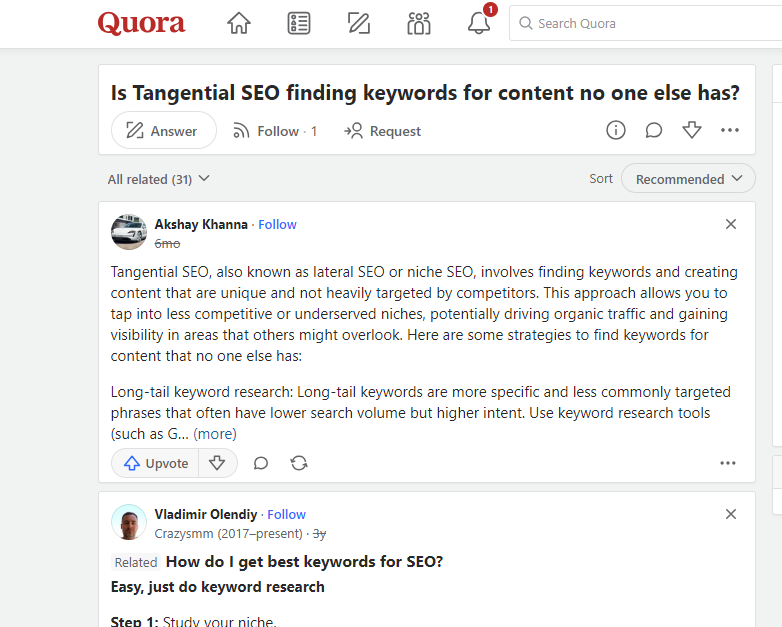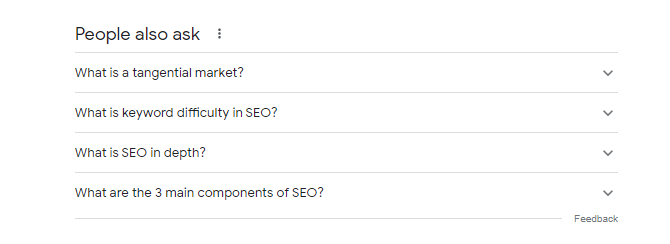Tangential SEO: Finding Keywords Your Competitors Neglected
Are you on a lookout for new clever ways to bump up your SEO performance? You are probably well-versed in keyword research, spying on your organic competitors, analyzing search terms volume, but there is always someone who covered that same topic first. If all that sounds familiar, you are not the only one. I will let you in on a secret - tangential SEO will help you stay original and ahead of the curve.
In a nutshell, keyword tangents are terms and phrases that are not directly related to your product or service but your target audience is curious about.The catch here is that while you and your competitors optimize your content for your main keywords “by default”, chances are very few players in your niche go beyond that. Users, however, demand to know far more than what everybody has already covered.
Unlike traditional SEO, which often revolves around direct keywords and industry-specific terms, tangential SEO explores the periphery, tapping into related topics that may be overlooked by competitors. This approach not only broadens a brand's digital footprint but also positions it as a leader and a high-authority source.
In this article, we will explore how tangential SEO practices differ from conventional methods, and highlight the benefits they can bring if done the right way. Also, we go through X steps to implement it in your content strategy.
By now, you must be burning with curiosity about this awesome secret SEO strategy, so let’s dive right in!
Traditional SEO Practices No Longer Cut It
Keyword research and SEO are not how they used to be.
Users have become more picky on quality and authority of online content. In fact, 58% of consumers don’t find branded online content meaningful. Therefore, there’s been a switch in search intent, the bar is much higher in the past and the competition for SERP domination is fierce.
That, coupled with frequent changes in search algorithms, has rendered conventional SEO tactics less effective. Keyword stuffing and a singular focus on high-volume keywords are no longer sufficient to guarantee prominent search engine ranking. The proliferation of content and the evolving preferences of search engines demand a more nuanced and innovative approach to SEO.
As important as smart tactics like tangential SEO are today, so is the solid website development and maintenance. After all, if your site doesn’t look professional, content will not work wonders to compensate for bad user experience.
WordPress is by far the best CMS for SEO due to its accessibility, popularity and functionality. With the opportunity to have a custom-made website with a theme and plugins tailored to your needs, a top WordPress agency is a must-have partner in crime. Mind you, professional web developers know their way around the latest coding hacks that will help achieve the results you are after.
Now that we’ve cleared that out, let’s cut to the chase - with a perfect website and professional maintenance, how can you utilize tangential SEO to enrich your content?
What Is Tangential Content?
Tangential content is a strategic approach in digital marketing where brands explore topics closely related to their core offerings but not directly centered on them. Unlike traditional content directly promoting products or services, tangential content delves into adjacent subjects that share relevance or appeal to the target audience. This content creation strategy involves providing valuable and contextually relevant information that goes beyond the immediate scope of a brand's primary focus.
The beauty of tangential content lies in its ability to attract new audiences by tapping into broader interests and addressing diverse queries. By offering insights, advice, or information related to but extending beyond the brand's central offerings, businesses can captivate a wider audience.
By identifying tangents of poorly covered topics online, you demonstrate your brand’s commitment to serve your customers and help them find all the info they might need.
Let’s have a quick look at the blog of one of the top WordPress development agencies, DevriX:

As you can see, they decided to cover a topic about pricing strategy, not really relevant to web development at first sight. However, since usually business owners look for professionals to build websites for their brand, the blog editors smartly sprinkled some diversity in the subjects they write about. This demonstrates expertise in helping their customers not only maintain quality online presence, but also succeed in business as a whole.
Benefits of Tangential SEO: Unlocking New Avenues for Success
We already mentioned the biggest advantage of tangential SEO - that is providing knowledge on scarcely covered topics in the industry users search for. However, it comes with so many more advantages, each contributing to the overall success of a business.
Increased Visibility
One of the primary benefits of adopting tangential SEO is the substantial increase in visibility. Traditional SEO tactics may saturate the competition around specific keywords, making it challenging to stand out. Tangential content, by exploring related topics and diversifying the content portfolio, allows businesses to capture attention in spaces where competitors might not be as present. This expanded visibility not only broadens the audience reach but also positions the brand as a comprehensive source of information.
Better Engagement
Tangential SEO is a gateway to improved engagement with audiences. By addressing a wider range of topics, brands can cater to diverse interests and answer varied queries. This approach encourages longer dwell times on websites, lower bounce rates, and increased interaction with the content. Engaging content that goes beyond the typical promotional material resonates with users, fostering a connection that goes beyond a transactional relationship.
Establishing Authority and Trust
Delving into tangential content allows businesses to establish authority and trust within their industry. By providing valuable, contextually relevant information, brands showcase their expertise and depth of knowledge. When consumers find comprehensive and reliable information from a source, it naturally builds trust. As businesses become go-to resources for not only their core offerings but also related subjects, they solidify their position as thought leaders, instilling confidence in their audience.
Connecting with New Audiences
Tangential SEO is a powerful tool for reaching new audiences. By exploring topics related to core offerings but not necessarily within the primary focus, businesses can attract individuals with broader interests. This enables brands to tap into diverse demographics, addressing the needs and preferences of a wider audience. Connecting with new audiences is vital for growth, and tangential SEO provides a strategic avenue for expanding a brand's consumer base.
Enhancing Content Variety
Tangential SEO encourages the creation of a diverse array of content formats. From articles and blog posts to videos, infographics, and more, this strategy allows brands to cater to different audience preferences. This versatility not only broadens the content spectrum but also maximizes the potential for engagement across various platforms and mediums.
10 Steps To Perform Tangential SEO: Navigating the Path to Digital Excellence
Tangential SEO, with its emphasis on exploring related topics and diversifying content, requires a strategic approach for effective implementation. To harness the full potential of this innovative strategy, businesses can follow these actionable steps:
Identify Target Audiences
The foundation of successful tangential SEO lies in a deep understanding of the target audience. Identify your ideal buyer persona, their demographics, interests, and preferences. Simultaneously, explore adjacent demographics that might be interested in related topics. Creating audience personas can help refine your content strategy and ensure that tangential content resonates with both existing and potential audiences.
Research Related Topics
Thorough research into related topics is essential for the success of tangential SEO. Identify subjects that complement your core offerings and align with the interests of your target audience. Utilize keyword research tools to uncover relevant search queries and topics with reasonable search volume.
Additionally, monitor industry trends, forums, consumer discussions, and competitor strategies to discover untapped areas for exploration. Bear in mind that all your competitors use SEO tools and track and optimize for the same “obvious” key phrases.
For example, let’s have a look at Quora for the topic we are ranting on about over here.

As you can see, the query in this screenshot is much more conversational and what the average user might ask themselves. Alternatively, you can check Google’s related searches and the People Also Ask feature:


Develop a Content Calendar
Organize your main tangential SEO findings by creating a content calendar. This is so that you do not have to look them up every time you write an article for your blog. Outline topics, publication dates, and content formats to maintain consistency. A well-structured calendar ensures a steady flow of content, allowing you to cover a spectrum of related subjects over time. This approach helps build momentum and keeps your audience engaged with a variety of content offerings.
Create High-Quality Content
Crafting high-quality content is the linchpin of successful tangential SEO. Focus on delivering valuable, informative, and engaging content that addresses the needs of your audience. Whether through articles, blog posts, videos, or infographics, prioritize quality over quantity. Ensure that your content aligns with user intent and provides solutions, insights, or entertainment relevant to the chosen tangential topics.
Optimize for Long-Tail Keywords
Incorporate long-tail keywords related to your tangential content. They are specific phrases that cater to niche queries and can drive targeted traffic to your site. Long-tail keywords are not necessarily tangential content. In fact, they can be directly related to your product but formulated in the ways users searching for such content would type them in. Integrate these keywords naturally within your content, headers, and meta tags. Long-tail optimization enhances the discoverability of your tangential content in search engine results, capturing the attention of users with specific interests.
Utilize Internal Linking
Integrate internal linking strategically within your tangential content. Linking to relevant pages within your website not only enhances user navigation but also signals to search engines the interconnectedness of your content. This approach contributes to a more robust SEO structure, improving the overall visibility and ranking potential of your tangential content.
Promote on Social Media
Leverage social media platforms to promote your tangential content. Share articles, snippets, or visuals on platforms where your audience is most active. Encourage engagement, discussions, and sharing. Social media promotion not only widens the reach of your content but also fosters a community around your brand, enhancing visibility and brand awareness.
Encourage User Participation
Invite user participation in discussions related to your tangential content. Encourage comments, ask questions, and seek opinions. User-generated content, in the form of comments or shared experiences, adds depth to your content and can inspire future tangential topics. Actively engaging with your audience fosters a sense of community and loyalty.
Monitor and Measure Success
Implement robust analytics tools to monitor the performance of your tangential SEO strategy. Track metrics such as website traffic, engagement levels, and keyword rankings. Assess the impact of tangential content on overall SEO performance and user behavior. Regularly review and refine your strategy based on these insights to optimize for continued success.
Adapt and Evolve
The digital landscape is dynamic, and consumer interests are ever-changing. Stay attuned to shifts in your industry, emerging trends, and evolving audience preferences. Adapt your tangential SEO strategy accordingly, exploring new related topics and adjusting your content calendar to reflect the evolving needs of your audience.
Conclusion
In conclusion, embracing tangential SEO proves to be a dynamic strategy for businesses navigating the complexities of the digital landscape. By diversifying content, addressing related topics, and engaging new audiences, brands can achieve heightened visibility and foster lasting connections. The benefits, including increased engagement, authority establishment, and expanded reach, underscore the significance of this innovative approach. With a strategic blend of targeted content creation, optimization, and consistent adaptation, tangential SEO becomes a pivotal tool for organizations aiming not only to stay competitive but to thrive in the ever-evolving online ecosystem.
Author's bio
Mariela Kashukeeva is an Outreach & Content Specialist at DevriX With over 6-year experience in SEO, she is responsible for establishing collaboration opportunities with high-authority websites and creating amazing content.
